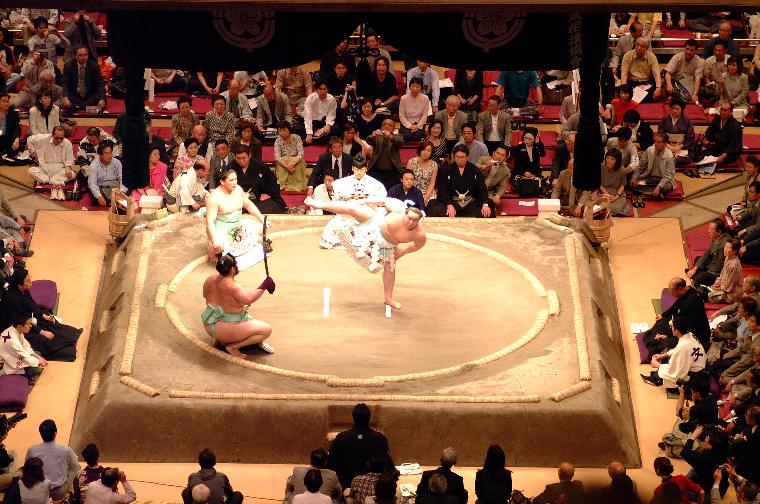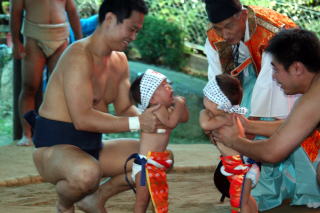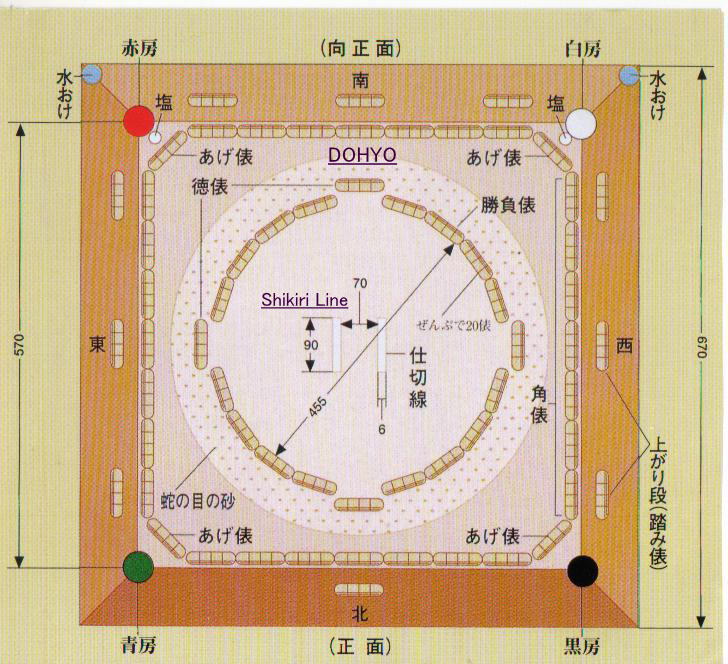相撲の概要英語版
Sumo
Out Line
Sumo is a sports that everyone can enjoy. The Japan Sumo Association(Nihon
Sumo Kyokai), a public corporate, is the organization that promotes sumo's
development as a mission. They are regularly holding ohsumo (professional
sumo wrestling tournament)6 times throughout a year. (January,March,May,July,September,November).Sumo
is fought by a tournament of 15 consecutive days.
Two sumo wrestlers so-called Rikishi wearing mawashi(sumo belt)only ,face
each other at both shikiri (the mark lined in white )of 70 cm in between
at the center of dohyo(solid sand mound of round shape) and rise to their
feet in the same breath within each limited time.
(4 minutes maximum for makuuchi(higher ranked sumo wrestlers)
,3 minutes for Juryo(middle ranked),
and 2 minutes for makushita and other(more lower ranked) . In ohsumo, there
is no classification in bout by weight. which is characteristically different
from western wrestling.
The rule is very simple. Stepping out from dohyo, Touch of any part of
body outside dohyo, Down into dohyo, Touch of any part of body but sole
to surface of dohyo and Faul. -These are judged to be lost in the match.
The judgment is done by gyoji(sumo referee)
butit is possible for maximum 5 other referees of ex-sumo wrestler watching
the match around dohyo to join the judgment.
There are 82 tricks and 5 non tricks and 8 fouls in sumo . Immediately
after match is over, both wrestlers ,regardless of bout outcome, have to
make a standing salutation with head down, respecting opponent for their
earnest fight politely. In the meantime, there are numerous amateur sumo
organizations which underpin ohsumo. It is possible for amateur to join
ohsumo. According to his outcome during his career of amateur age, he could
be starting from grade 10th to 15th of makushita. On the other hand, ex-sumo
wrestler is often coaching amateur . As such, they are cooperating each
other. We have, for example, Japan Sumo Confederation, Student Sumo Confederation
of National& Public University, Wanpaku(impish boy)SumoAssociation,
and so on. There are also a lot of sumo contest and/or championship of
amateur prevailing nationally and internationally. Amateur sumo is following
most of ohsumo rule but sometimes they make an exceptional rule to have
the match by age or weight as follows; By Age = Classification of elementary,
middle and high school and university and open By Weight = Less Than 65
kg, LT75kg, LT85kg, LT100kg, LT115kg LT135kg and Free By Trick = Same 82
tricks and 5 non tricks as ohsumo, but such dangerous acts as sabaori,
(give mawash i a jerk with downward strength ),kubinage(neck throw),and
sorinage (backward throw)are prohibited. Gyoji =One main referee and minimum
one sub referee Wears Allowed = Under-pants are possible for elementary
and middle school boys Sumo originally meant to wrestle strength with others,
so that the original Chinese letter for sumo was expressed as “角力”which
derives from “角てい”during Shin dynasty. Even today, we often say角界 for sumo
circle. There are similar sports as sumo available in other parts of world;Bufu
in Mongol , Shirumu in Korea and wrestling in Turkey and other parts of Eurasia continent. A mural painting of caves alongside the Nile River of 2,500 years ago depicts men’s bout of wresting. So, it may be said that bout is an intuitive expression of healthy human beings to show his strength It also symbolizes each local character. And some had developed to current wrestling and other to sumo. Today, we have seen an influx of hopeful youngsters from overseas countries into ohsumo to compete with native Japanese sumo wrestlers.
, Shirumu in Korea and wrestling in Turkey and other parts of Eurasia continent. A mural painting of caves alongside the Nile River of 2,500 years ago depicts men’s bout of wresting. So, it may be said that bout is an intuitive expression of healthy human beings to show his strength It also symbolizes each local character. And some had developed to current wrestling and other to sumo. Today, we have seen an influx of hopeful youngsters from overseas countries into ohsumo to compete with native Japanese sumo wrestlers.
Sumo was originated for male sports but nowadays, sumo for female called
“New Sumo ”is also available. For this, an organization called Japan New
Sumo Confederation exists.
Sumo wrestler shall not be allowed to wear any but mawashi, but in case that he is injured , he is allowed to wear bandage, supporter, and white socks. This means that any seemingly offensive wears are not allowed to use in sumo bout. Sumo was originally a part of Shinto (Japanese indigenous religion)events. Most shrines held sumo contest when a festive was held there. It was called as a dedicated sumo to shrine. Ohsumo sometimes hold a touring sumo at Ise Shrine and Yasukuni Shrine. They also hold a dedicated sumo at Meiji Shrine when a new year comes and new Yokozuna( Champion sumo wrestler) inaugurates. When wrestlers are displayed in the ring, they clap their hands and Yokozuna tightens his tsuna(rope)mawashi. These derive from Shime-Nawa of Shinto. And Shiko(stamping) is an important practice of sumo trainings and at the same time, it means to drive evil- spirits away, stamping them down to the earth.
You also see that they clap their hands and extend their arms
to both ends and turn their palm down to the ground immediately after wrestlers
are displayed in the ring. This shows they have no weapons in their hands
and fight with unarmed. And other Shinto related sumo events are such as
that when dohyo-biraki(commencement of practice at dohyo) of each sumo-beya(training
room run by a factional boss of ex-sumo wrestlers)starts or on the very
day before a regular sumo tournament begins, dohyo-matsuri(something like
Shinto’s religious ceremony to purify the site praying for no accident
of construction or safety of buildings) is held for praying no accident
at dohyo during the tournament. Gyoji, acting as Shinto priest, recites
Shinto prayer and offers sacred wine, chestnut, washed rice, surume( dried
squid), salt, thatch seed and tangle to four corners of dohyo by which
he could purify dohyo. As such, dohyo deems to be a sacred place.
Until Meiji era started, no female could be permitted to see sumo. Even
today, it is somehow controversial to have a female at dohyo.
As a rare Shinto event, there are “Naki-Sumo”(Weeping Sumo)  and “ Tori-Sumo”(Raven Sumo). The former is to pray for infants steady
growth . Many shrines and temples throughout this country have long been
succeeding this tradion, while the latter storied that Kamotake-Tsunuminomikoto,
the grand father of the founder of Kamigamo Shrine in Kyoto led The Emperor
Jinmu to conquer his enemies resided in eastern Japan in his disguise of
a huge and wondrous raven and contributed a lot to its success. Sumo symbolizes
this religious event, driving evil-spirits away from a sacred place. In
fact, a sumo wrestler in disguise of Tone (warrior) holding a bow and arrow
imitates raven cawing and afterward, boys used to play sumo. Whenever we
have a festive, we are to hold sumo championship at the festive site. Originally,
shape and largeness of dohyo had not been fixed. some were square and others
round but in dual rounds. The largeness of dohyo was rather smaller than
current one. Currently, it is regulated that it should be round in encircled
with 20 small straw bags and 4.55 m in diameter while two shikiri(getting
off the mark) of white color must be lined at 70 cm in between at the center
of dohyo.
and “ Tori-Sumo”(Raven Sumo). The former is to pray for infants steady
growth . Many shrines and temples throughout this country have long been
succeeding this tradion, while the latter storied that Kamotake-Tsunuminomikoto,
the grand father of the founder of Kamigamo Shrine in Kyoto led The Emperor
Jinmu to conquer his enemies resided in eastern Japan in his disguise of
a huge and wondrous raven and contributed a lot to its success. Sumo symbolizes
this religious event, driving evil-spirits away from a sacred place. In
fact, a sumo wrestler in disguise of Tone (warrior) holding a bow and arrow
imitates raven cawing and afterward, boys used to play sumo. Whenever we
have a festive, we are to hold sumo championship at the festive site. Originally,
shape and largeness of dohyo had not been fixed. some were square and others
round but in dual rounds. The largeness of dohyo was rather smaller than
current one. Currently, it is regulated that it should be round in encircled
with 20 small straw bags and 4.55 m in diameter while two shikiri(getting
off the mark) of white color must be lined at 70 cm in between at the center
of dohyo.
Sumo was originated long before dating back to era of The Emperor
Suinin in A.D.360 Since then until now, it has been loved by all layers
of people; nobles, warriors, laymen of this country with slight modifications
but the basic mode unchanged. Sumo is widely accepted in Shinto events,
local festivals, amateur sports and ohsumo, and thus, it is really worthy
to be called national game. It can also be developed to a further extent
and prevailed overseas countries as well. Sumo , together with Judo and
Kendo(Japanese fencing), became a compulsory subject of middle school athletics
from the year 24th Heisei(A.D.2012). Therefore, we can expect an increasing
number of students who select and practice sumo, thus building up a stout
body with a polite and high moral. And sumo also became well-known even
in foreign countries and those who love sumo are increasing to come to
Japan to enjoy sumo bout firsthand.

 Back to the Sumo page 相撲 四季通販 へ戻る
Back to the Sumo page 相撲 四季通販 へ戻る
site map サイトマップ
 Back to the Sumo page 相撲 四季通販 へ戻る
Back to the Sumo page 相撲 四季通販 へ戻る
 , Shirumu in Korea and wrestling in Turkey and other parts of Eurasia continent. A mural painting of caves alongside the Nile River of 2,500 years ago depicts men’s bout of wresting. So, it may be said that bout is an intuitive expression of healthy human beings to show his strength It also symbolizes each local character. And some had developed to current wrestling and other to sumo. Today, we have seen an influx of hopeful youngsters from overseas countries into ohsumo to compete with native Japanese sumo wrestlers.
, Shirumu in Korea and wrestling in Turkey and other parts of Eurasia continent. A mural painting of caves alongside the Nile River of 2,500 years ago depicts men’s bout of wresting. So, it may be said that bout is an intuitive expression of healthy human beings to show his strength It also symbolizes each local character. And some had developed to current wrestling and other to sumo. Today, we have seen an influx of hopeful youngsters from overseas countries into ohsumo to compete with native Japanese sumo wrestlers. 
 and “ Tori-Sumo”(Raven Sumo). The former is to pray for infants steady
growth . Many shrines and temples throughout this country have long been
succeeding this tradion, while the latter storied that Kamotake-Tsunuminomikoto,
the grand father of the founder of Kamigamo Shrine in Kyoto led The Emperor
Jinmu to conquer his enemies resided in eastern Japan in his disguise of
a huge and wondrous raven and contributed a lot to its success. Sumo symbolizes
this religious event, driving evil-spirits away from a sacred place. In
fact, a sumo wrestler in disguise of Tone (warrior) holding a bow and arrow
imitates raven cawing and afterward, boys used to play sumo. Whenever we
have a festive, we are to hold sumo championship at the festive site. Originally,
shape and largeness of dohyo had not been fixed. some were square and others
round but in dual rounds. The largeness of dohyo was rather smaller than
current one. Currently, it is regulated that it should be round in encircled
with 20 small straw bags and 4.55 m in diameter while two shikiri(getting
off the mark) of white color must be lined at 70 cm in between at the center
of dohyo.
and “ Tori-Sumo”(Raven Sumo). The former is to pray for infants steady
growth . Many shrines and temples throughout this country have long been
succeeding this tradion, while the latter storied that Kamotake-Tsunuminomikoto,
the grand father of the founder of Kamigamo Shrine in Kyoto led The Emperor
Jinmu to conquer his enemies resided in eastern Japan in his disguise of
a huge and wondrous raven and contributed a lot to its success. Sumo symbolizes
this religious event, driving evil-spirits away from a sacred place. In
fact, a sumo wrestler in disguise of Tone (warrior) holding a bow and arrow
imitates raven cawing and afterward, boys used to play sumo. Whenever we
have a festive, we are to hold sumo championship at the festive site. Originally,
shape and largeness of dohyo had not been fixed. some were square and others
round but in dual rounds. The largeness of dohyo was rather smaller than
current one. Currently, it is regulated that it should be round in encircled
with 20 small straw bags and 4.55 m in diameter while two shikiri(getting
off the mark) of white color must be lined at 70 cm in between at the center
of dohyo.